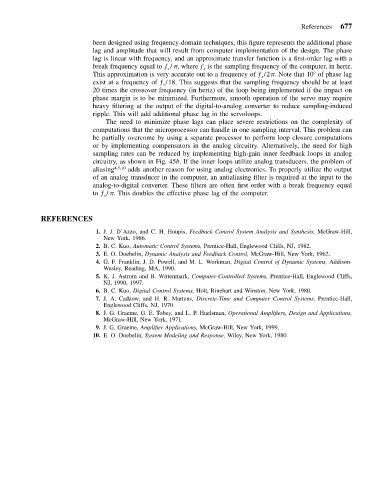Page 686 - Mechanical Engineers' Handbook (Volume 2)
P. 686
References 677
been designed using frequency-domain techniques, this figure represents the additional phase
lag and amplitude that will result from computer implementation of the design. The phase
lag is linear with frequency, and an approximate transfer function is a first-order lag with a
break frequency equal to ƒ / , where ƒ is the sampling frequency of the computer, in hertz.
s
s
This approximation is very accurate out to a frequency of ƒ /2 . Note that 10 of phase lag
s
exist at a frequency of ƒ /18. This suggests that the sampling frequency should be at least
s
20 times the crossover frequency (in hertz) of the loop being implemented if the impact on
phase margin is to be minimized. Furthermore, smooth operation of the servo may require
heavy filtering at the output of the digital-to-analog converter to reduce sampling-induced
ripple. This will add additional phase lag in the servoloops.
The need to minimize phase lags can place severe restrictions on the complexity of
computations that the microprocessor can handle in one sampling interval. This problem can
be partially overcome by using a separate processor to perform loop closure computations
or by implementing compensators in the analog circuitry. Alternatively, the need for high
sampling rates can be reduced by implementing high-gain inner feedback loops in analog
circuitry, as shown in Fig. 45b. If the inner loops utilize analog transducers, the problem of
aliasing 4,5,10 adds another reason for using analog electronics. To properly utilize the output
of an analog transducer in the computer, an antialiasing filter is required at the input to the
analog-to-digital converter. These filters are often first order with a break frequency equal
to ƒ / . This doubles the effective phase lag of the computer.
s
REFERENCES
1. J. J. D’Azzo, and C. H. Houpis, Feedback Control System Analysis and Synthesis, McGraw-Hill,
New York, 1966.
2. B. C. Kuo, Automatic Control Systems, Prentice-Hall, Englewood Cliffs, NJ, 1982.
3. E. O. Doebelin, Dynamic Analysis and Feedback Control, McGraw-Hill, New York, 1962.
4. G. F. Franklin, J. D. Powell, and M. L. Workman, Digital Control of Dynamic Systems, Addison-
Wesley, Reading, MA, 1990.
5. K. J. Astrom and B. Wittenmark, Computer-Controlled Systems, Prentice-Hall, Englewood Cliffs,
NJ, 1990, 1997.
6. B. C. Kuo, Digital Control Systems, Holt, Rinehart and Winston, New York, 1980.
7. J. A. Cadzow, and H. R. Martens, Discrete-Time and Computer Control Systems, Prentice-Hall,
Englewood Cliffs, NJ, 1970.
8. J. G. Graeme, G. E. Tobey, and L. P. Huelsman, Operational Amplifiers, Design and Applications,
McGraw-Hill, New York, 1971.
9. J. G. Graeme, Amplifier Applications, McGraw-Hill, New York, 1999.
10. E. O. Doebelin, System Modeling and Response, Wiley, New York, 1980.

